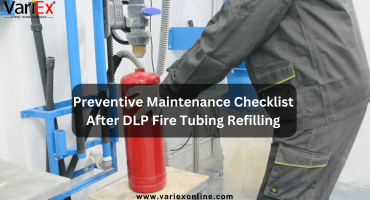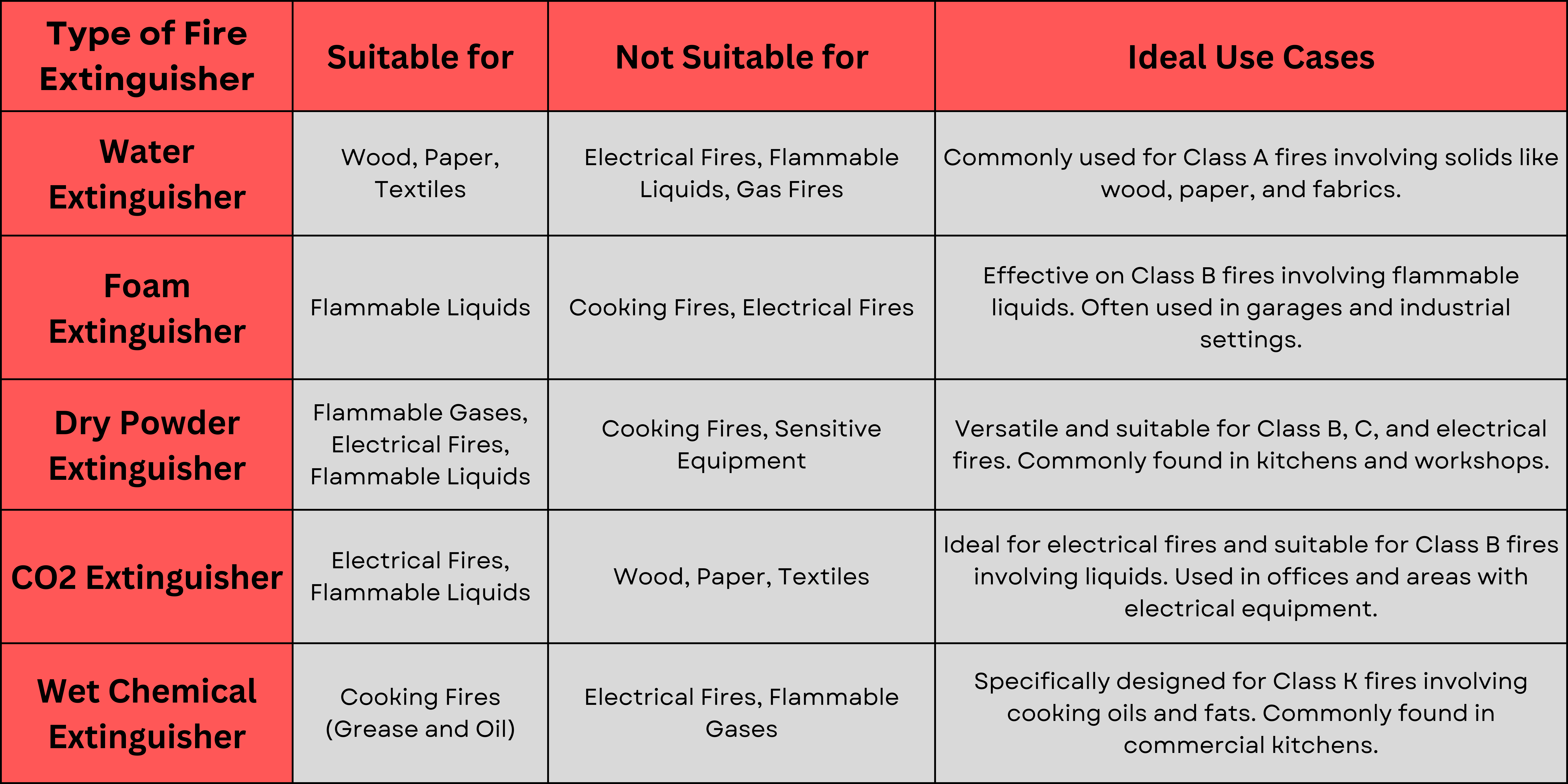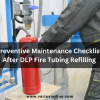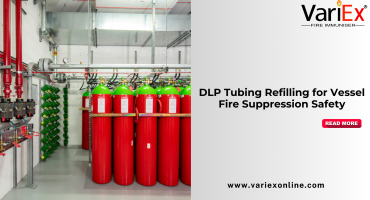![]()
Fire Immuniser
+91-7829629111
Email: info@variex.in
Varistor Technologies Pvt. Ltd.
Block-1, First Floor, Ardente Office One, Hoodi Circle, ITPL Main Road, Bengaluru, Karnataka 560048, IN
What are the procedure used for refilling fire extinguisher?
In a world where fire safety takes center stage, one pressing question arises: "What are the procedures used for refilling fire extinguisher?" Fire extinguishers serve as silent guardians against potential disasters, and understanding how to keep them at their best is crucial. The process of refilling these life-saving devices is simpler than one might think, akin to recharging a superhero's powers. In this exploration, we'll unravel the uncomplicated yet vital steps involved in refilling a fire extinguisher, breaking down each task into layman's terms. Whether you're a business owner or a concerned homeowner, this journey into the basics of fire extinguisher maintenance is a step toward ensuring the ongoing safety of those you care about.
Imagine a world without fire extinguishers, where the smallest flame could turn into a raging inferno, threatening lives and property. Thankfully, fire extinguishers stand as silent sentinels, ready to leap into action when the need arises. However, have you ever wondered how these life-saving devices are replenished and kept in optimal condition? In this discussion, we'll delve into the straightforward yet crucial process of refilling a fire extinguisher, demystifying the steps in simple, everyday language.
Fire extinguishers are like the unsung heroes of fire safety, patiently waiting on walls or in designated spots, poised to tackle flames before they grow uncontrollable. The process of refilling them is akin to recharging a superhero's powers, ensuring they are always ready to defend against the fiery villains that may unexpectedly appear in our lives.
Unlike the complex machinery seen in action movies, the procedure for refilling a fire extinguisher is surprisingly straightforward. It involves a series of steps that anyone can grasp, making it accessible for both professionals and the average person concerned with safety. Whether you're a business owner responsible for workplace safety or a homeowner safeguarding your family, understanding the basics of fire extinguisher refilling is a valuable skill.
In the following sections, we will break down the process into bite-sized pieces, discussing each step in a way that resonates with everyday experiences. From checking the gauge to assessing the type of extinguishing agent used, this exploration will empower you with the knowledge needed to keep your fire extinguishers in top-notch shape. So, let's embark on this journey through the realm of fire safety, demystifying the procedure of refilling fire extinguishers in layman's terms.
Understanding Fire Extinguishers
Fire extinguishers are like superhero sidekicks for tackling fires before they get out of control. They come in those red canisters you see on walls. Each has a specific job - some fight wood and paper fires, others tackle liquids or electrical ones.
Here's the trick: remember PASS. Pull the pin, Aim the nozzle, Squeeze the handle, and Sweep side to side. It's like using a can of spray paint, but instead, you're putting out a fire.
The colors on the extinguisher matter too. The label color tells you what kind of fire it fights. It's like a color code for superheroes – red for general fires, blue for electrical, and so on. So, next time you spot a fire extinguisher, know that it's not just there for show. It's a handy sidekick, ready to jump into action and save the day.
Inspection and Assessment
Refilling a fire extinguisher involves more than just topping off its contents; it's a comprehensive process that ensures the device is ready to be a hero in case of a fire emergency. This undertaking requires a careful inspection and assessment to guarantee that every component is in optimal condition.
Picture the process like giving your car a thorough check-up before a long road trip. When it comes to fire extinguishers, the first step is assessing the external appearance. Fire safety experts look at the canister for any signs of damage, ensuring that it's sturdy and intact. Like a superhero's armor, the canister needs to be in top shape to withstand the pressures of firefighting.
Next up, the pressure gauge becomes a focal point. It's like checking the fuel gauge in your car. The pressure gauge on a fire extinguisher indicates the readiness of its firefighting powers. If the needle is in the green zone, it's good to go. However, if it's in the red, it signals that the extinguisher needs attention. This simple but critical check ensures that the extinguisher has the necessary force to dispense its firefighting agent effectively.
Opening up the extinguisher reveals its inner workings, much like a mechanic inspecting the engine of a car. Fire safety experts examine the inside for any signs of corrosion or damage. The extinguishing agent, whether it's powder or foam, is also scrutinized to make sure it's not clumped or compromised. This agent is the superhero's power source, and it needs to be in prime condition for the extinguisher to perform at its best.
The inspection doesn't stop there. The hoses and nozzles are examined for any blockages or wear and tear. It's like ensuring the hoses in your garden are free from kinks and leaks before watering your plants. A clear path ensures that when the time comes, the extinguisher can deliver its firefighting agent accurately and efficiently.
Lastly, the inspection considers the expiration date. Yes, fire extinguishers have an expiration date, much like perishable goods. This date ensures that the extinguisher's components, including its internal chemical makeup, remain effective. It's akin to checking the expiration date on food to ensure its freshness and reliability.
The Safe Discharge of Extinguishing Agent
When it comes to fire extinguishers, their job doesn't end with putting out fires; they also need proper care during decommissioning and discharge to guarantee they remain reliable for future emergencies. Think of it as a superhero returning from a mission – they need a thorough check and some care before being ready for the next call to action.
Decommissioning involves more than just retiring a fire extinguisher; it's a strategic process to ensure that the device is safely taken out of service without causing any harm. This stage is crucial for extinguishers that have reached the end of their lifespan or have undergone significant wear and tear.
The first step in decommissioning is discharging the extinguishing agent. Imagine it like emptying the fuel tank of a car before putting it in storage. This ensures that the extinguisher is safe to handle during the next phases of decommissioning. It's a careful process, akin to a controlled superhero landing after a high-flying rescue mission.
Next, proper depressurization takes the center stage. Fire extinguishers are pressurized containers, and releasing this pressure is essential for safe handling and disposal. Much like safely releasing built-up steam from a pressure cooker, depressurization ensures that the extinguisher can be dismantled without any unexpected surprises.
Now, let's focus on the safe discharge of the extinguishing agent. It's like making sure a water gun is empty before storing it. This step involves carefully expelling any remaining agent from the extinguisher, ensuring that it doesn't inadvertently discharge during handling or disposal. This discharge is controlled and directed away from people or sensitive environments, preventing any unintended mess or harm.
Proper depressurization also involves ensuring that the pressure is released slowly and steadily. It's comparable to letting air out of a balloon gradually rather than all at once. This controlled release minimizes the risk of injury and guarantees a safe handling process for both professionals and users involved in the decommissioning.
Once the extinguishing agent is safely discharged, and the pressure is released, the extinguisher undergoes a final assessment. This is similar to a superhero undergoing a post-mission health check-up. The canister and its components are inspected for any remaining residues, ensuring that the extinguisher is entirely safe and ready for the next phase – whether it be disposal or refurbishment.
Component Replacement During Fire Extinguisher Recharge
Recharging a fire extinguisher is akin to giving it a new lease on life – ensuring it's ready to combat fires with renewed vigor. As part of this process, several key components undergo replacement, guaranteeing the extinguisher's reliability and effectiveness.
Think of the components like the various parts of a car engine that need attention during a tune-up. O-rings and seals, for instance, play a crucial role in maintaining the integrity of the fire extinguisher. These small yet mighty elements create a tight seal, preventing the extinguishing agent from leaking or evaporating. During recharge, worn-out O-rings and seals are replaced, ensuring the extinguisher remains airtight and ready for action.
The pressure gauge is another critical component that undergoes scrutiny. Much like the fuel gauge in a car, the pressure gauge on a fire extinguisher provides vital information about its readiness. Over time, these gauges can become inaccurate or dysfunctional. During recharge, they are replaced to provide precise readings, giving users confidence in the extinguisher's ability to deliver its firefighting agent when needed.
Imagine the pressure gauge as the heart rate monitor for the fire extinguisher – it needs to be in optimal condition for an accurate assessment of its health. A malfunctioning pressure gauge could lead to misjudgments about the extinguisher's readiness, emphasizing the importance of its replacement during the recharge process.
Indicators, which signal the type of fire the extinguisher is designed to combat, also get a refresh during the recharge. These indicators are like road signs, guiding users to the right extinguisher for specific fire types. Replacing them ensures that users can easily identify and deploy the extinguisher for the appropriate fire, enhancing its effectiveness.
Sealing and Testing During Fire Extinguisher Refilling
When refilling a fire extinguisher, it's not just about adding more stuff – it's like making sure the superhero suit fits perfectly before a mission. Sealing is about fixing any leaks and ensuring everything stays inside until it's needed. It's like patching up a water bottle so it doesn't drip.
Then comes testing – the big rehearsal. We check if the extinguisher can shoot out its firefighting stuff properly, like making sure a water gun works before a water fight. We also make sure all the buttons and indicators, if there are any, do their job. It's like checking your TV remote to see if it still changes channels.
Sealing and testing are the final checks, making sure our fire extinguishers are in top-notch shape and ready to be the heroes they are meant to be when a fire emergency strikes.
Final Inspection in Fire Extinguisher Refilling
When refilling a fire extinguisher, the final inspection is like the last check before a big game. We give it a once-over to make sure everything is good to go.
We look at the outside to make sure the canister is in good shape, like checking your toolbox before a project. The pressure gauge gets a close look – it's like making sure the battery in your flashlight is working. If it's in the green, we know the extinguisher is charged up and ready.
Then, we check the nozzle and hoses, similar to making sure your water hose isn't all tangled up before watering the plants. Everything needs to be in tiptop shape, so when you need it, the fire extinguisher is set to do its job.
Think of the final inspection as the last-minute prep before showtime. It ensures our trusty fire extinguisher is in its best shape, ready to be the hero when a fire emergency comes knocking.
In conclusion, understanding the procedures for refilling a fire extinguisher unveils the meticulous and vital steps involved in maintaining these silent guardians of safety. From the initial assessment and discharge to component replacements, sealing, testing, and final inspection, each phase plays a crucial role in ensuring the extinguisher stands ready for its life-saving mission. Just like a superhero gearing up for action, a refilled fire extinguisher is not just a passive tool on the wall; it's a meticulously prepared defender, equipped to face the unexpected challenges of a fire emergency. Through this exploration, we grasp that refilling a fire extinguisher is not a routine task but a comprehensive process, underscoring the importance of meticulous care and attention in safeguarding lives and property.
Frequently Asked Questions
1.Why is it necessary to refill a fire extinguisher?
Refilling ensures that the extinguisher is fully charged and ready for effective use. Over time, pressure may decrease, and components may wear out, making refilling crucial for optimal performance.
2. How often should a fire extinguisher be refilled?
The frequency of refilling depends on factors like the type of extinguisher and local regulations. Generally, professionals recommend an annual inspection, with refilling done as needed.
3. What happens during the initial assessment of a fire extinguisher?
The initial assessment involves checking the external condition, inspecting the pressure gauge, and evaluating the type of extinguishing agent. It helps determine if the extinguisher needs refilling or other maintenance.
4. Can I refill a fire extinguisher myself?
Refilling should be done by trained professionals. DIY attempts may lead to incorrect agent mixtures, improper pressurization, or safety hazards. Always seek the expertise of certified technicians.
5. How is the extinguishing agent discharged during the refilling process?
The extinguishing agent is discharged in a controlled manner, usually through a hose. This allows for safe disposal or recycling of the agent, ensuring environmental responsibility.
Final Say
We at VariEx.in or Variexonline.com have mastered the art of designing, installing, inspecting, and fixing automatic sprinkler systems with the help of our in-house team, which is capable of delivering the fire sprinkler services you need, whether large or small and at affordable cost.
To schedule a fire sprinkler installation, or you think our services could benefit your commercial property, contact us online or give us a call at, 7829629111
"WHAT YOU CAN READ NEXT"
 Read more +24 November 2023 in Fire Extinguisher
Read more +24 November 2023 in Fire ExtinguisherWhat types of fire extinguishers are available for different fire classes?
 Read more +11 July 2025 in Fire Suppression
Read more +11 July 2025 in Fire Suppression







